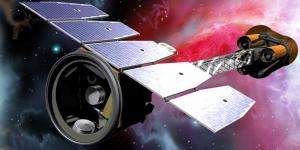IXPE (Imaging X-ray Polarimetry Explorer), shown scanning a nebula in this artist's concept, will use X-ray telescopes to look for highly magnetized objects, including jets of hot gas from black holes and the remnants of exploded stars. It is scheduled for launch this fall. [NASA]
You are here
IXPE
The space around a black hole can be busy. As gas funnels into a black hole, it can form a disk that’s heated to millions of degrees. And the spin of the disk and the black hole can create a strong magnetic field. The field can sculpt powerful “jets” that shoot gas from the disk into space at almost the speed of light.
Astronomers should learn more about that process with a space telescope that’s scheduled for launch this fall. It’s called IXPE — the Imaging X-Ray Polarimetry Explorer.
The craft will carry three telescopes that are sensitive to X-rays, which are produced by some of the most powerful objects and events in the universe. The telescopes will feed light to instruments that will detect X-rays that have been polarized — they move through space in sync, like members of a marching band. The X-rays can be polarized by magnetic fields, so studying them reveals how the fields align, how they’re created, and more.
The list of targets includes black holes large and small, plus the remnants of exploded stars. Among those remnants are magnetars. These tiny, ultra-dense corpses produce magnetic fields that are trillions of times stronger than Earth’s. IXPE should map those fields, helping scientists determine how magnetars are born, how they evolve, and how they affect the space around them.
IXPE isn’t the only space telescope being prepared for launch. We’ll talk about a much bigger one tomorrow.
Script by Damond Benningfield
Get Premium Audio
Listen to today's episode of StarDate on the web the same day it airs in high-quality streaming audio without any extra ads or announcements. Choose a $8 one-month pass, or listen every day for a year for just $30.




